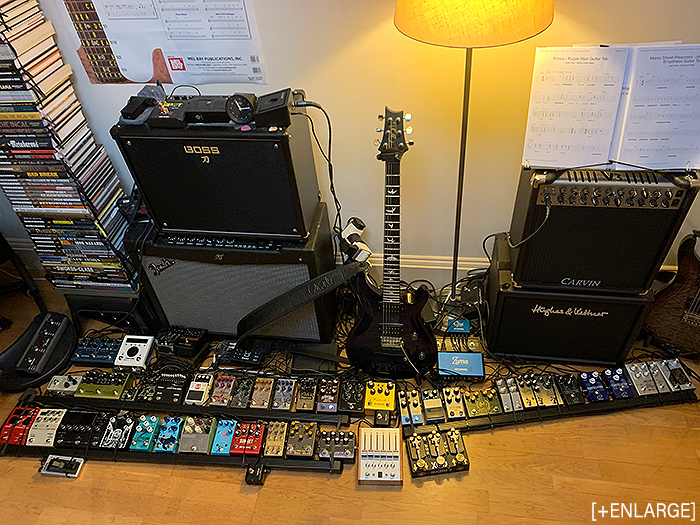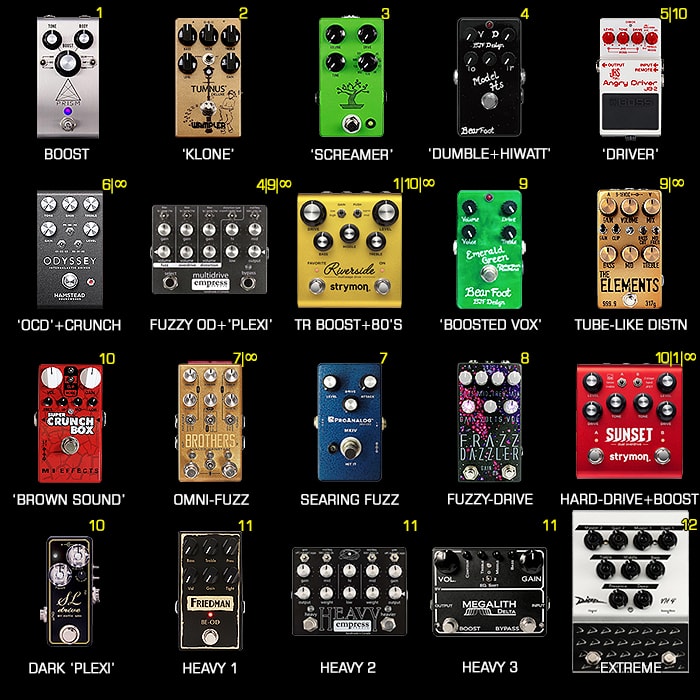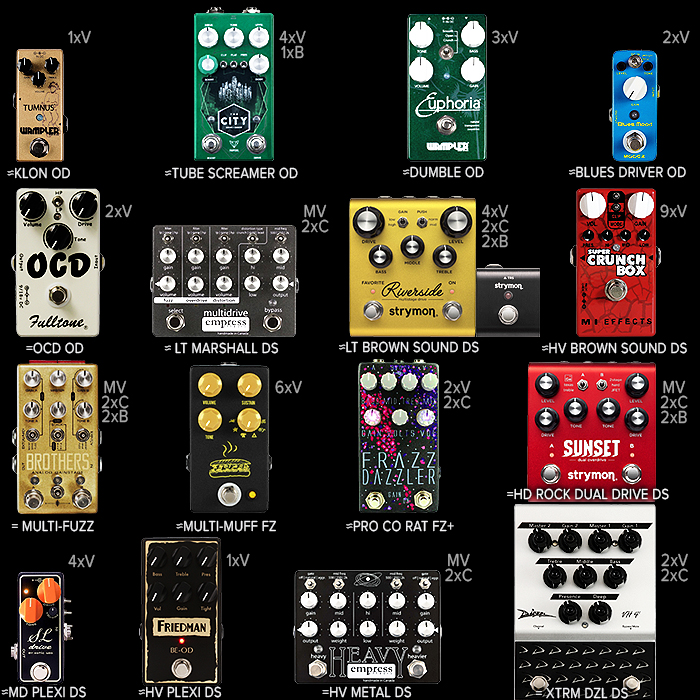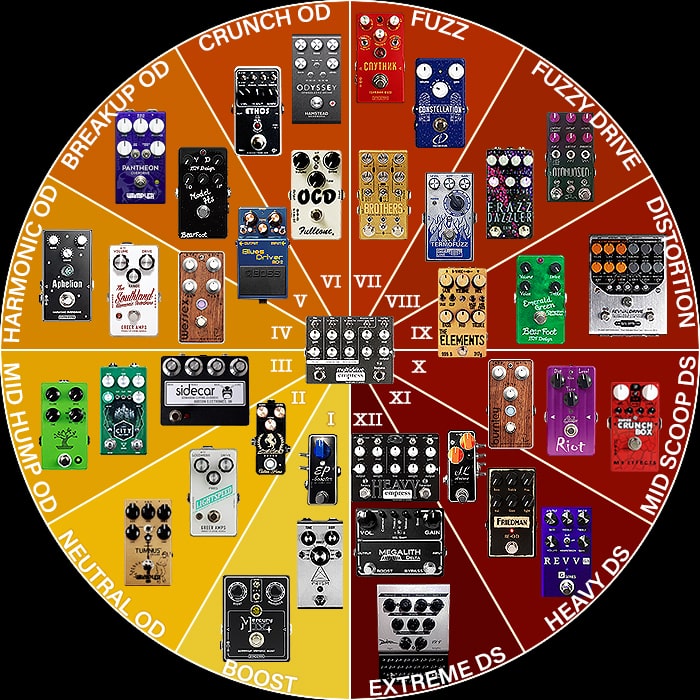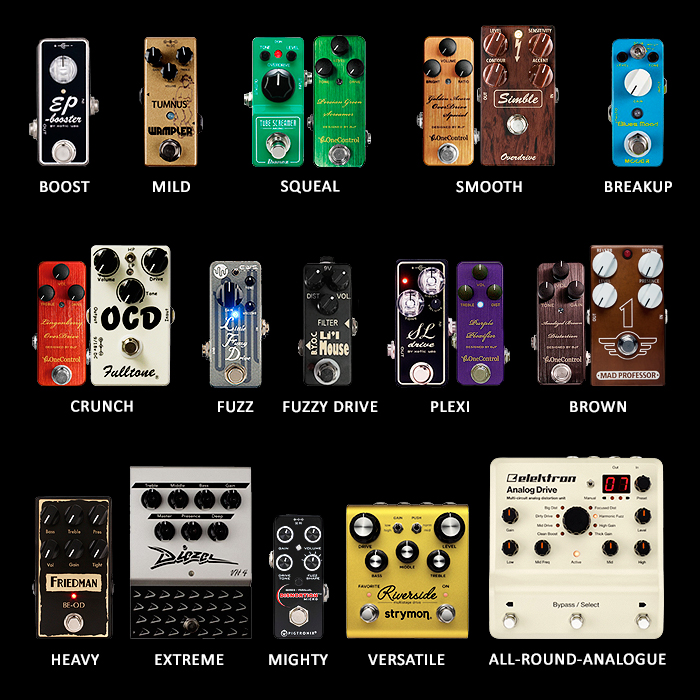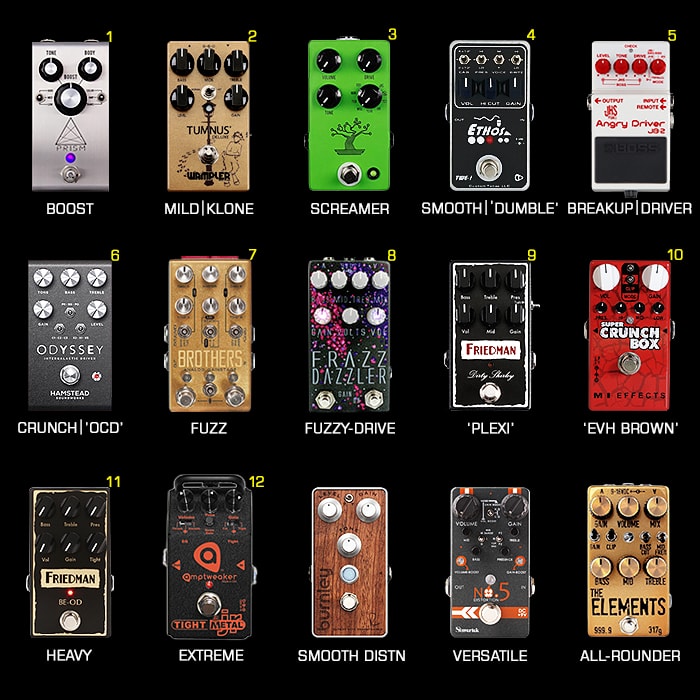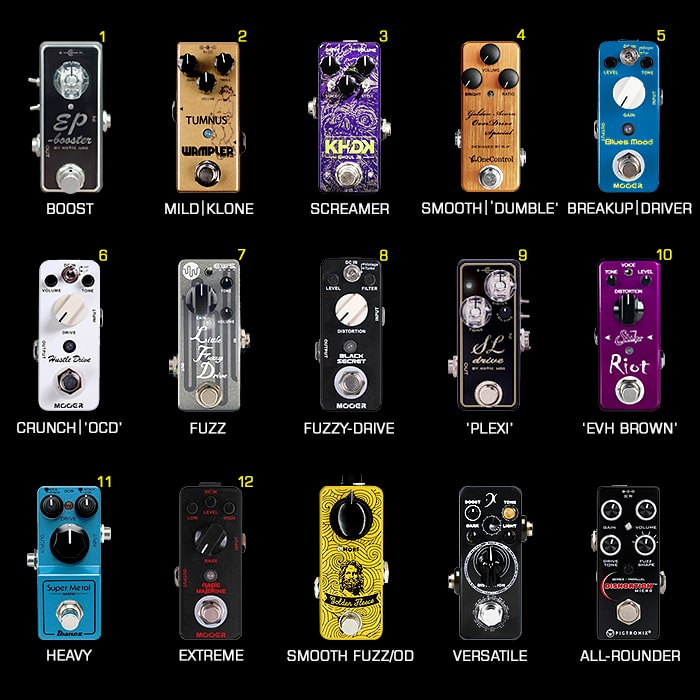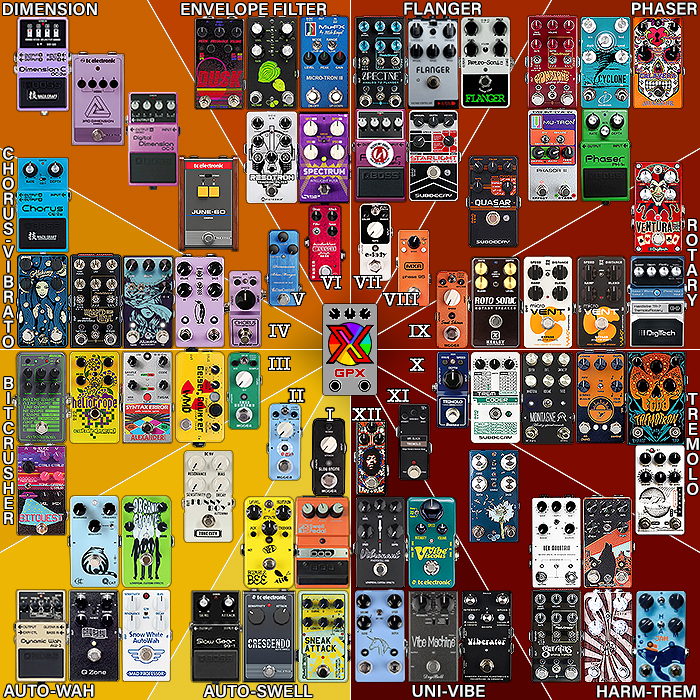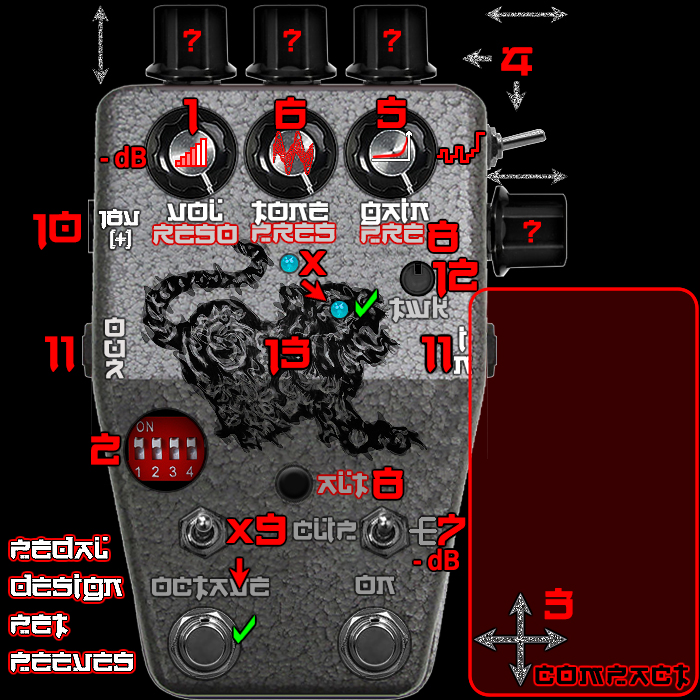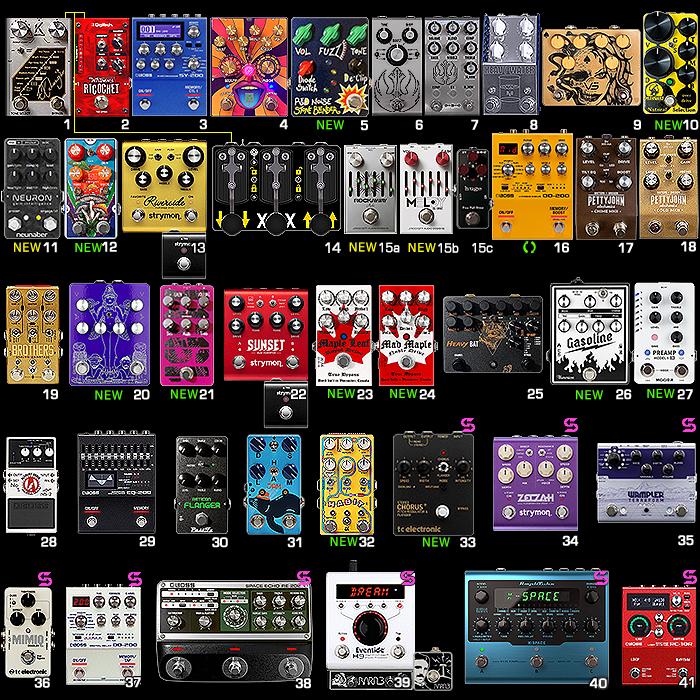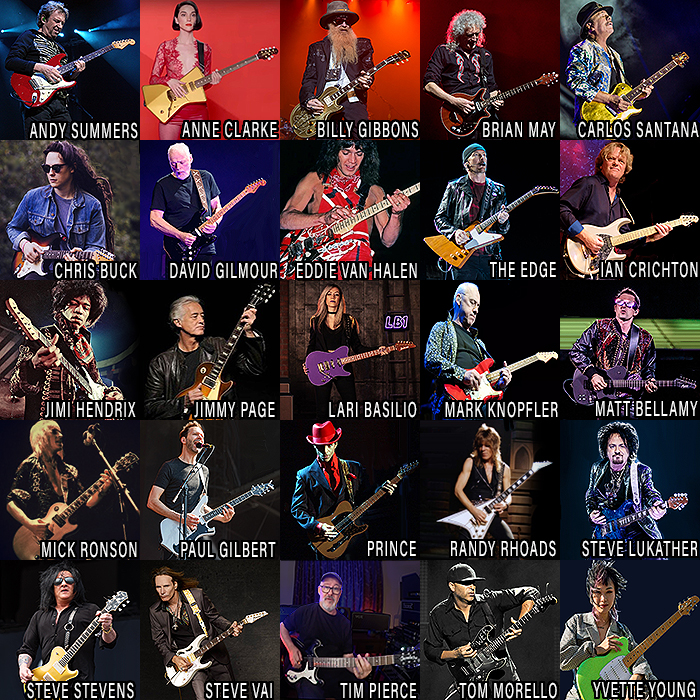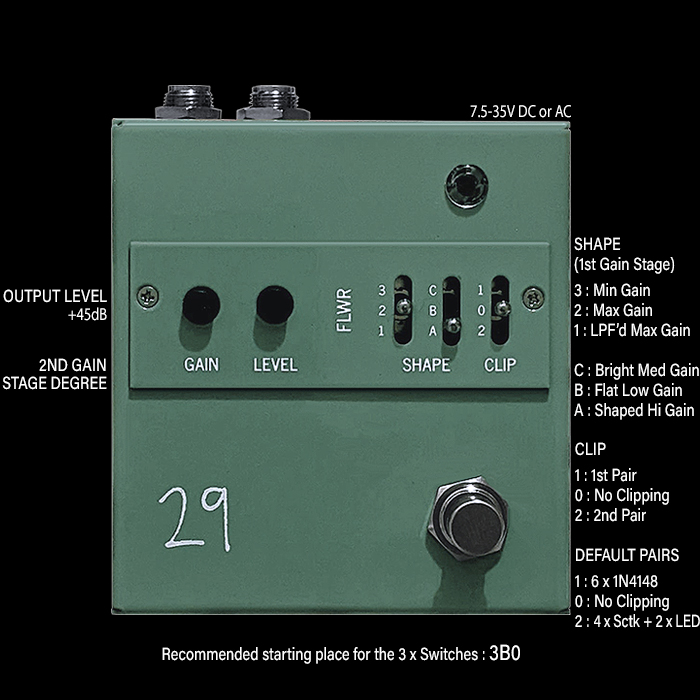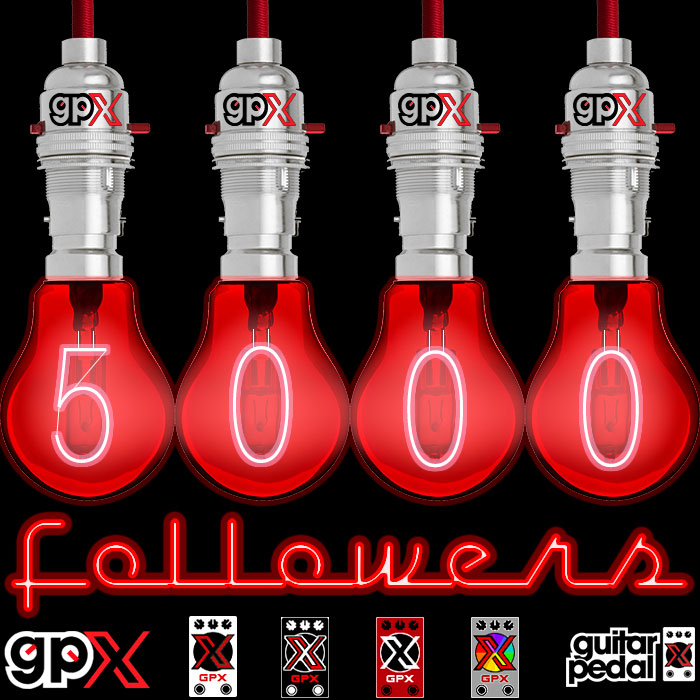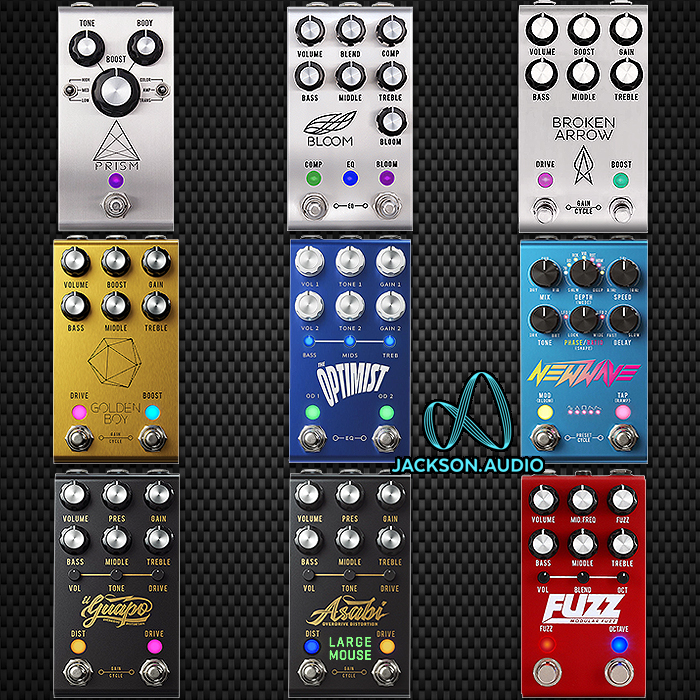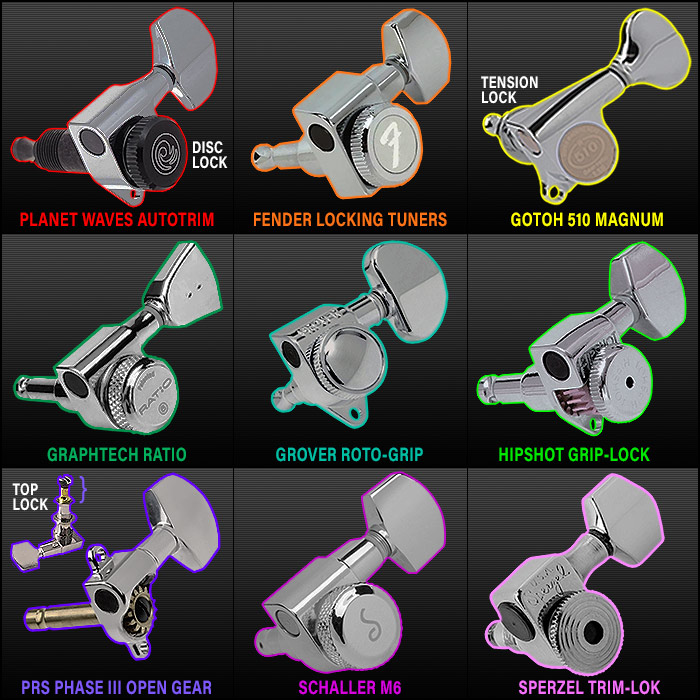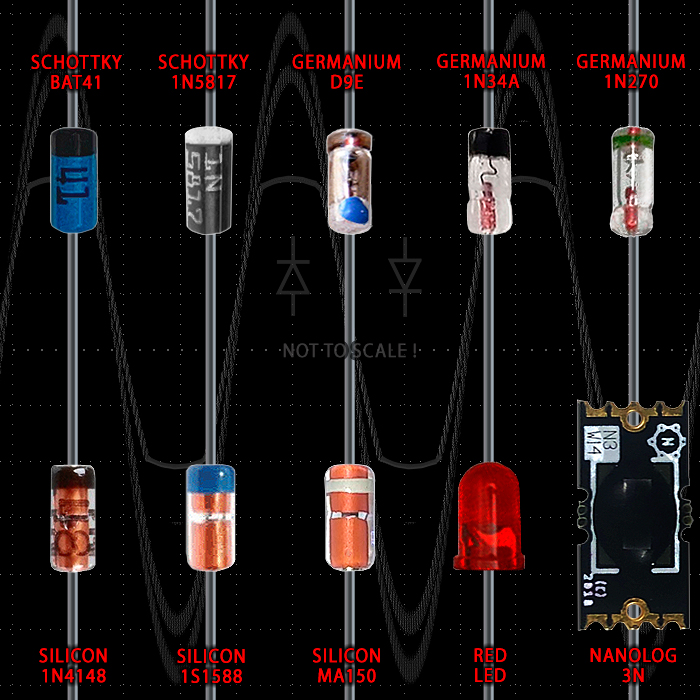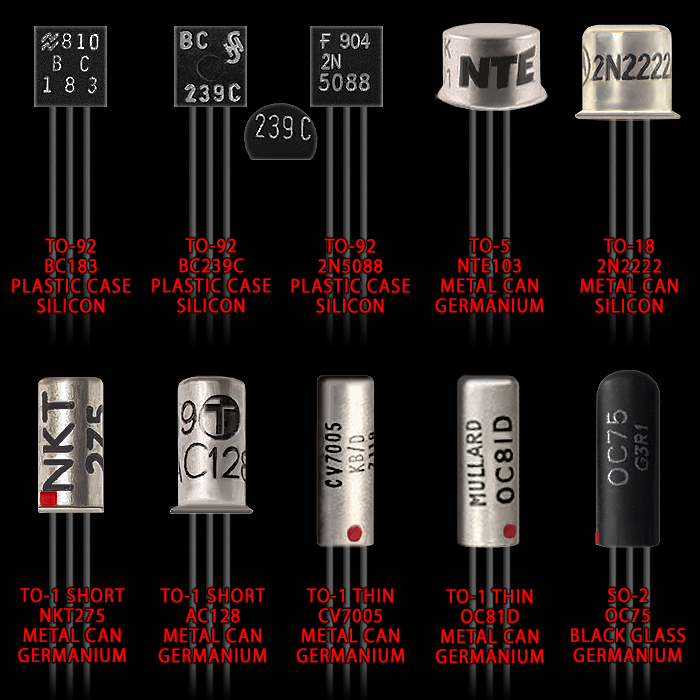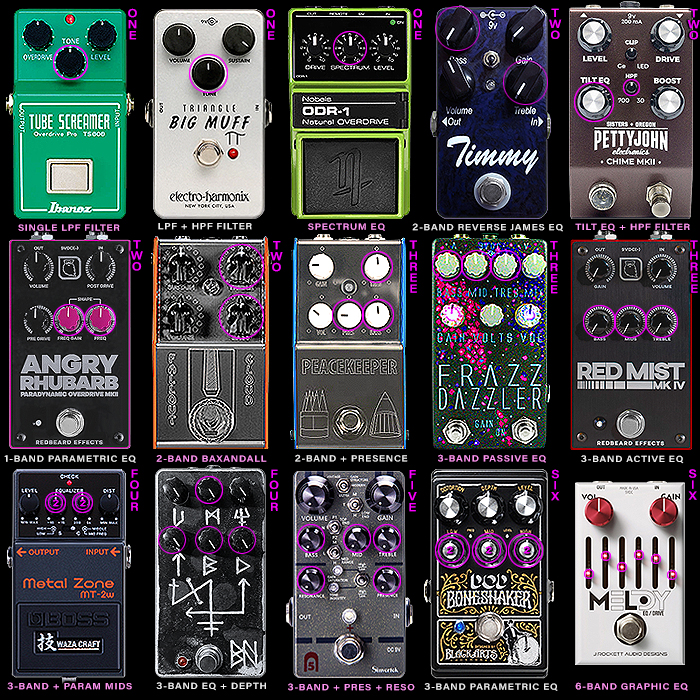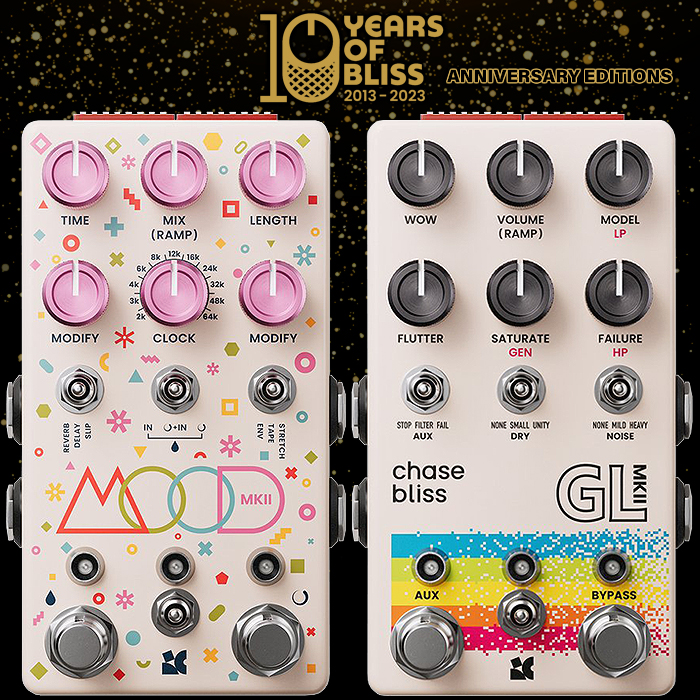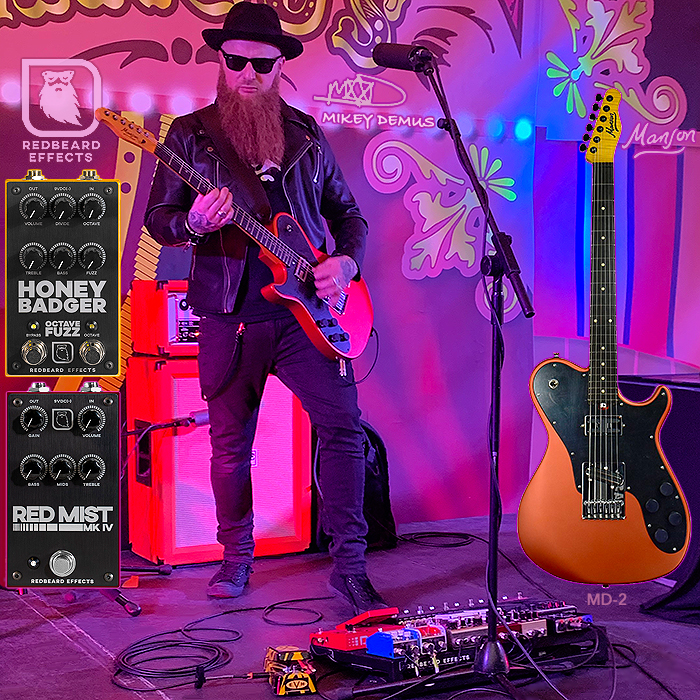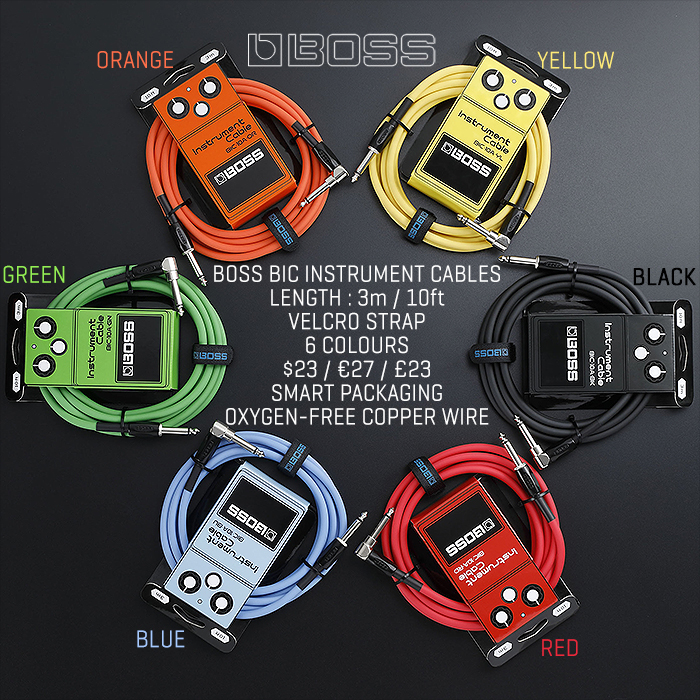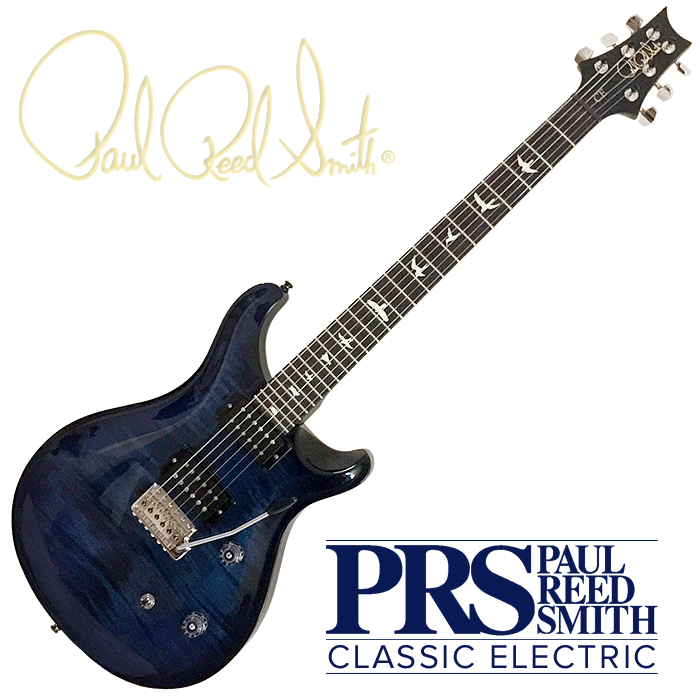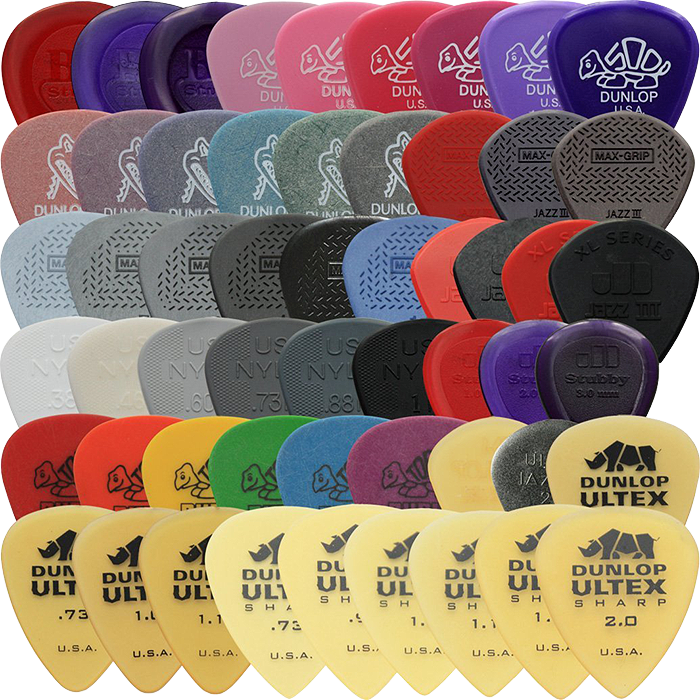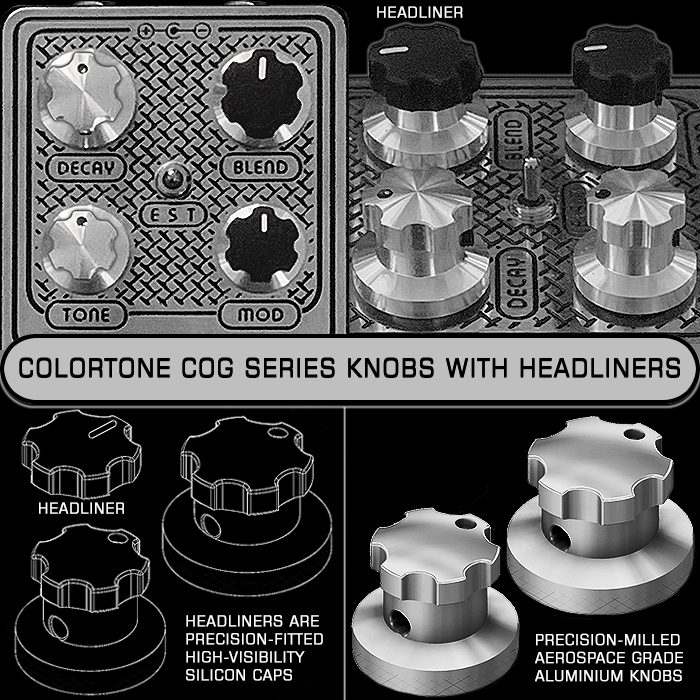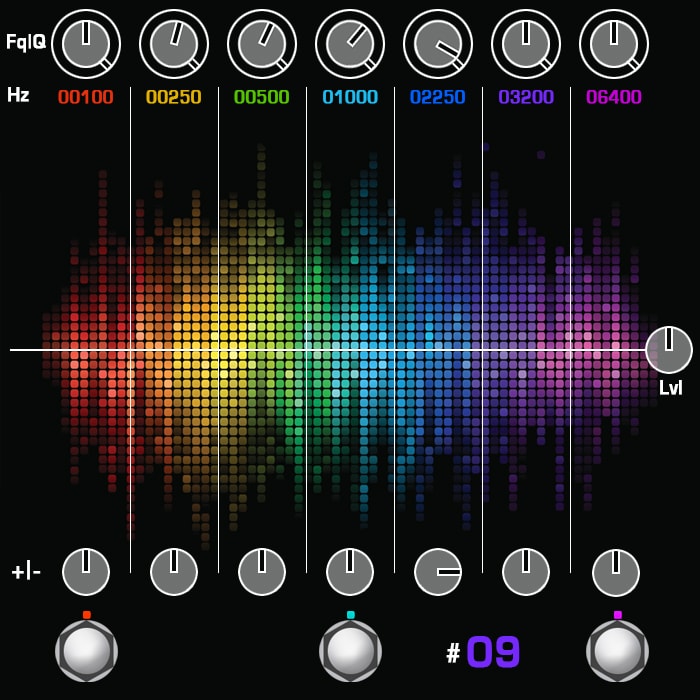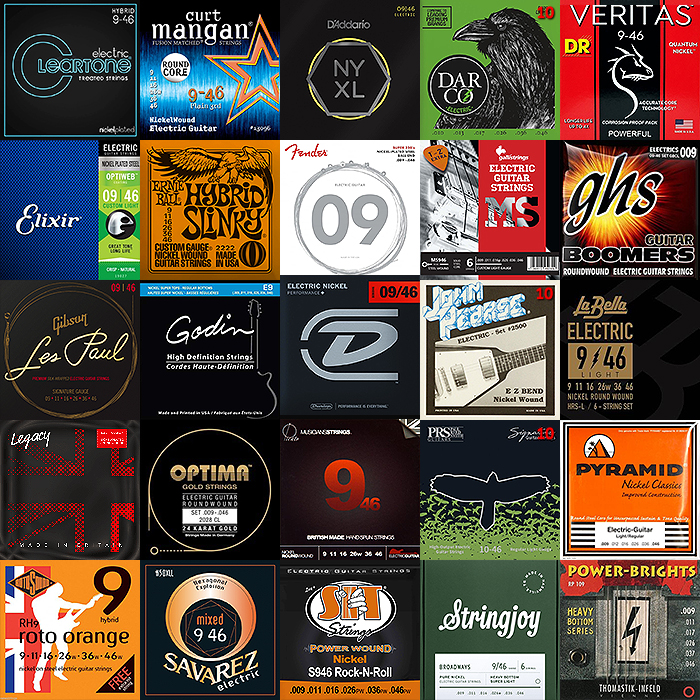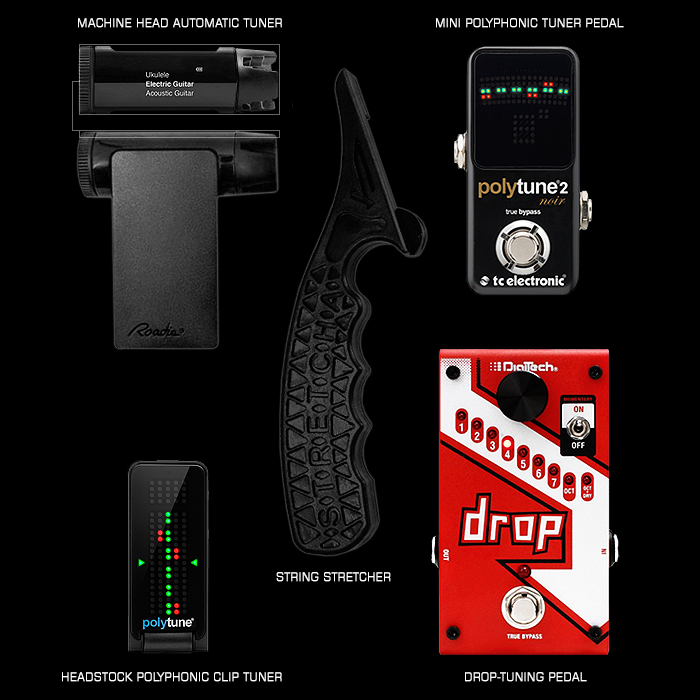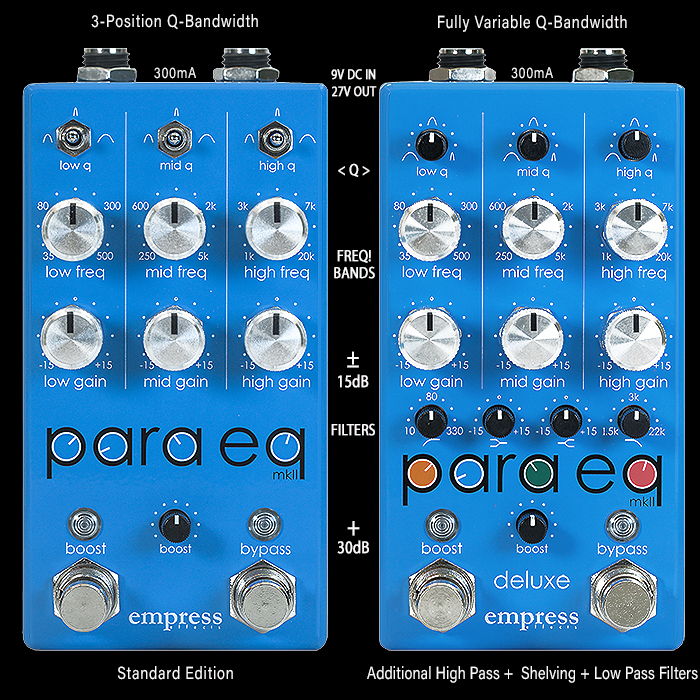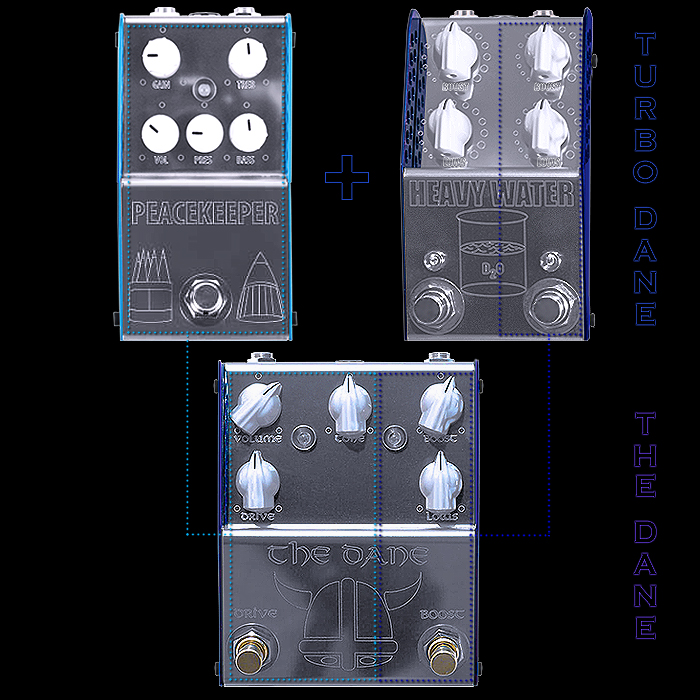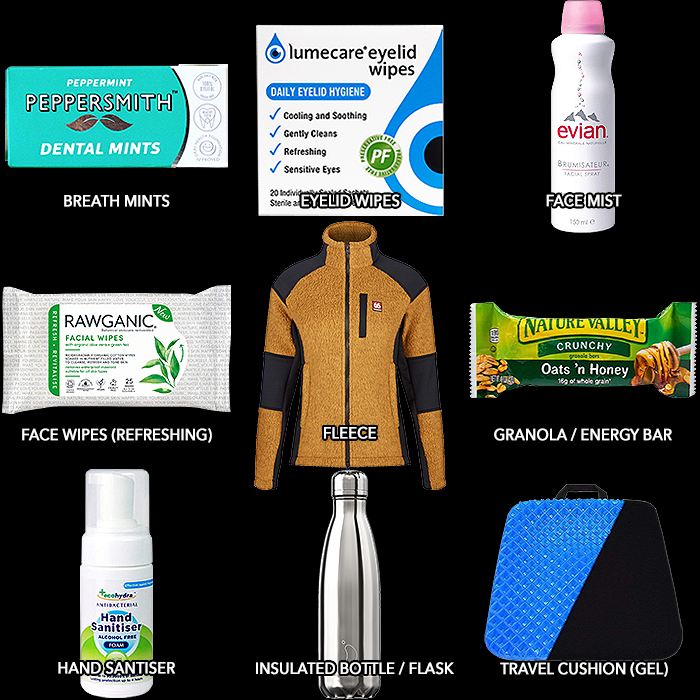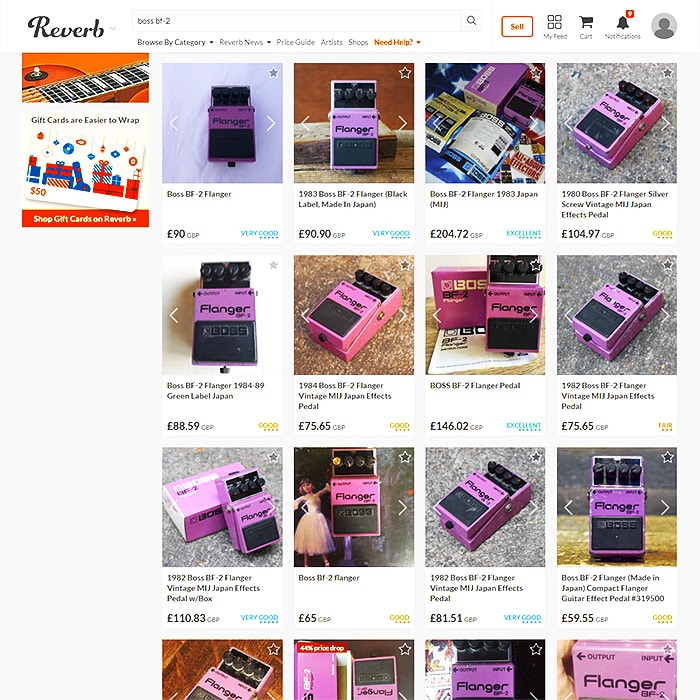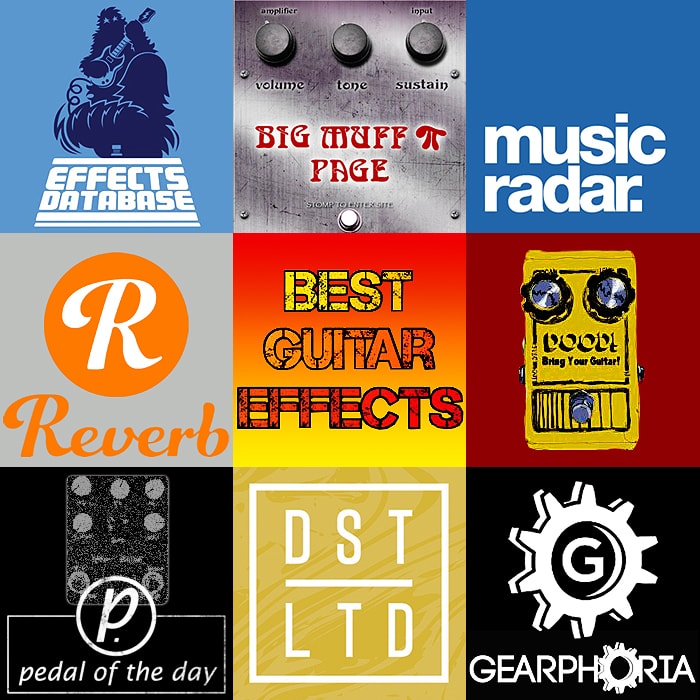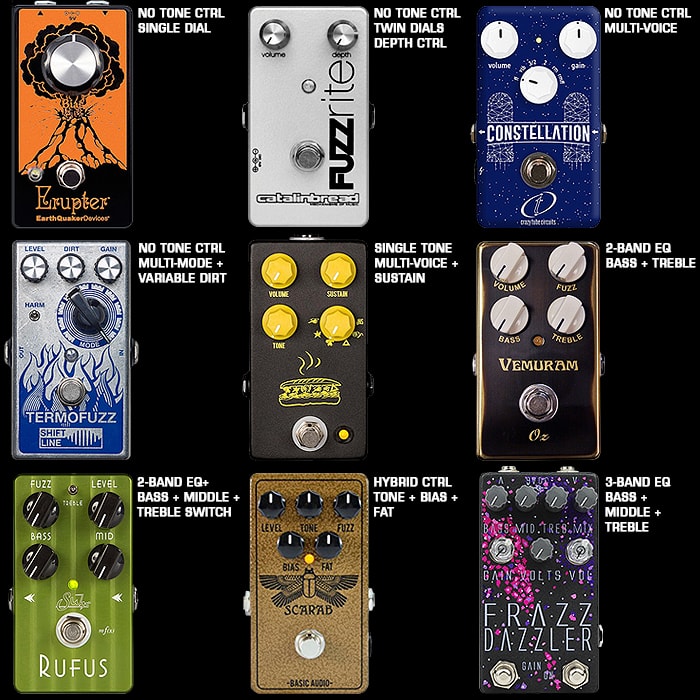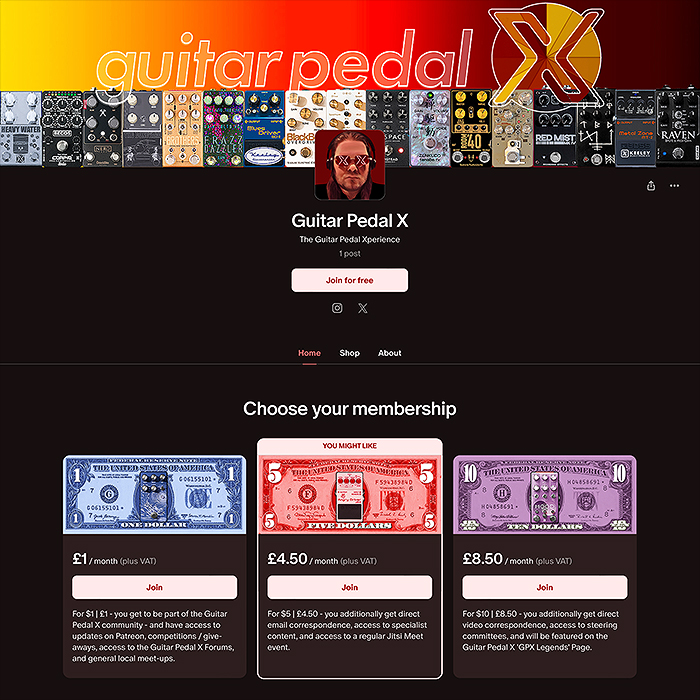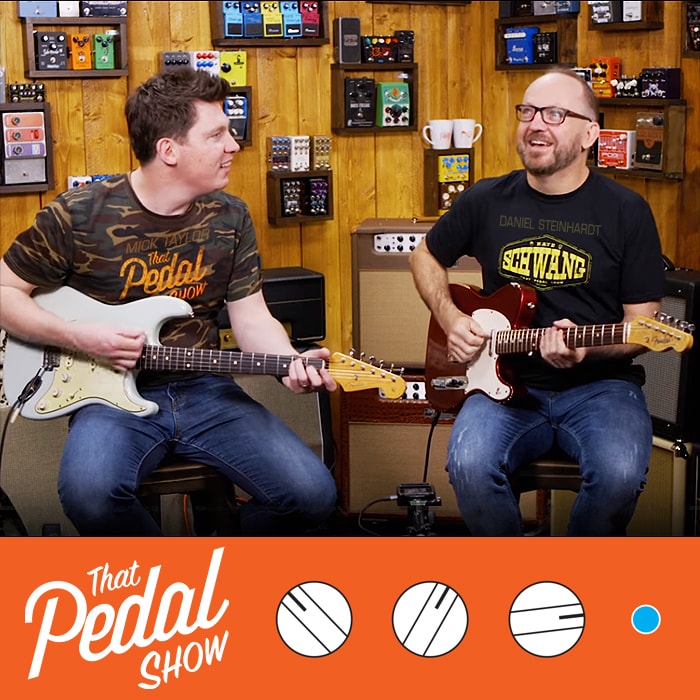The Method behind the Madness - an Explainer Feature on the Inner Workings and Science of my Pedal-Chain / Pedal Platform Stereo Rig

So I’ve had a lot of people ask me to explain the reasoning and science behind my 41-strong Pedal-Chain - how it came about, and how it has evolved.
The funny thing is that when I got back into guitar in 2016 - following the passing of my two biggest musical heroes and inspirations - Bowie and Prince - I had intended to keep things very streamlined and simple. As a teenager I struggled to recreate the sounds of my guitar heroes and kind of threw in the towel after a few years of trying and getting nowhere close to sounding like those legendary recordings.
Obviously things had moved on heaps by the time I got involved again - and the first thing I encountered was a demo of do-everything modelling amps - in fact the Fender Mustang III I believe. So I determined that I would buy the best guitar I could comfortably afford - a circa £2K Paul Reed Smith Classic Electric - and one of those new-fangled modelling amps. I was though sorely disappointed with the tones and in particular textures that emanated - despite some degree of quality and a vast range of different styles. So I was encouraged to go down the pedal / stompbox route - to experiment and dig deep into individual guitar effects pedals - and there it was that I finally started to be able to recreate my versions of those sounds that I had in my head.
I started off in Mono with a single amp - which quickly became the Boss Katana 100 (the perfect pedal platform amp), while all the time I was experimenting with Tube amps too - gradually evolving into more of a stereo setup with the Katana 100 EL34 emulating combo on the left channel, and the Carvin V3MC EL84 Tube Amp on the right.
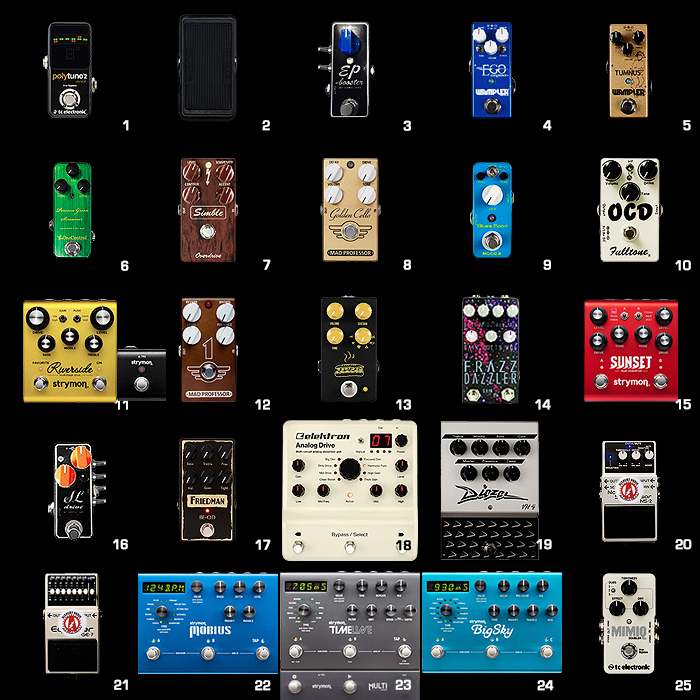
Over about 15/16 months I gradually honed and evolved the makeup of the pedal-chain - where its first proper published arrangement 'Pedal Chain Delight' was in April of 2017 - with then a more modest 25 pedals in the chain.
This blog originally started up largely as an exercise for me to compile and compare all the different options available to me and decide which pedal/s would best serve my purposes. This involved a lot of classifications and comparisons - where I evolved my know well-known '12 Degrees of Saturation' methodology to help me place different gain pedals on the gain spectrum - so that I was sure that I was really comparing like with like. It's all a bit of a grey science, but there are some salient inherent parts - even though the first editions of 12 degrees weren't wholly correct in their assumptions - but near enough, and said methodology has served me very well throughout.
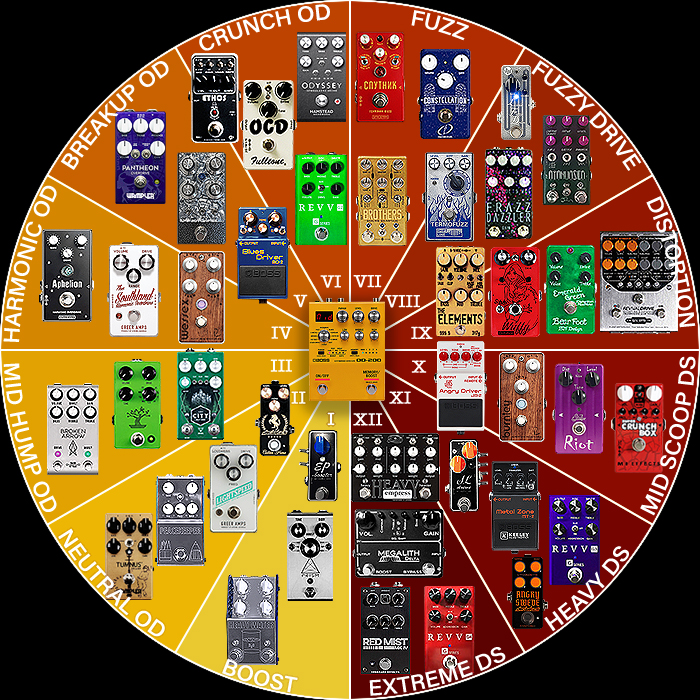
12 Degrees of Saturation sets out a spectrum of gain - illustrated by bright yellow at the lowest hue of gain - or Boost / Clean Boost, we then move through 12 overlapping categories overall to a deep dark red at the Extreme end. The idea is to roughly place pedals within that spectrum so that when you're choosing a particular boost, overdrive, fuzz or distortion - you know what properly to head-to-head compare it against.
The pedal-chain sort of evolved on a similar trajectory - but with some quirks and exceptions - but generally moving from the lowest of low gain throughout to the most ear-splittingly heavy and extreme!
This explainer article details pretty much every facet of the chain - namely :
- The Rig
- The Non-Pedalboard Innovation
- Initial Input-Sensitive Pedals
- The 3 Key Tone Enhancers / Sweeteners / Boosts
- The Gain Section
- The Purpose of the Multiple EQs and Boosts Peppered throughout the chain!
- The Utility Pedals
- The Modulation Section
- The Stereo Time-Based Effects
- Power and Cable
- Instrument Cable & Wireless
- Amps and #1 Guitar
- The Pick of Destiny!

A snapshot of the Rig from April 2021 - with the typical monthly update schematic diagram below the actual photographed setup!
The Non-Pedalboard Innovation - Thule Roof Rack Bar Kick Plates with Cable Ties
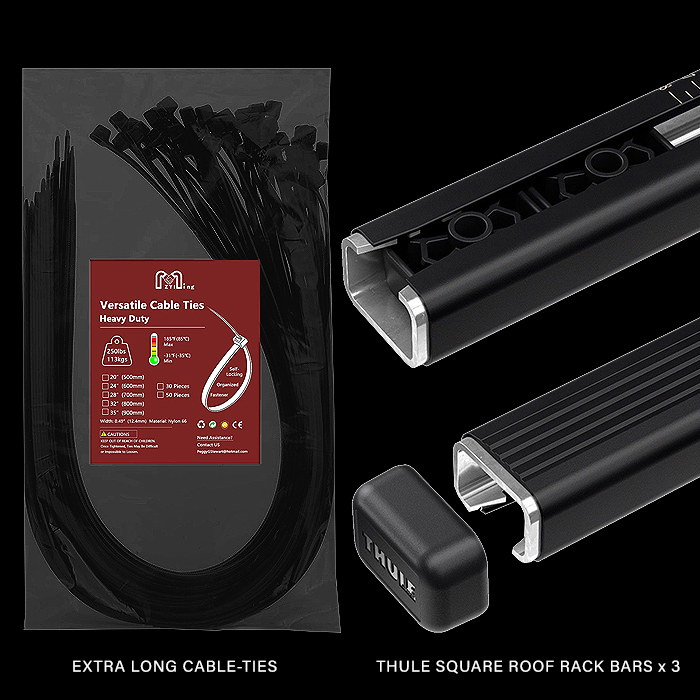
People often ask me what pedalboard I use / recommend - where my favourites tend to be Schmidt Array, Holeyboard and Templeboard. I personally actually use none.
My pedal arrangement just isn't really accommodated by any system - while I really needed something physical to anchor my pedals to.
The major innovation here is using Roof Rack Bars as 'kick-plates' - with Extra Long Cable Ties pinning core and perennial pedals to said bars - while everything else is pretty free-form. I've noted that I can change half a dozen or more pedals per week, and up to half the board over the month. I deploy all manner of different pedals in different order - and different sizes. So I need something with the maximum of flexibility.
I evolved the systems of Roof Rack Bars as kick-plates and anchors - to which key pedals were fixed by Cable Ties. The bars are heavy steel that has been plastic-coated and has endcaps - which actually makes for a really elegant and robust solution. Alas the 3 highest quality Thule Square Roof Bars are discontinued now - they came in various lengths - in pairs - and where I acquired one pair at 108cm, and one at 120cm - which were then cut down to size with a hacksaw - and finished off with those elegant endcaps.
This system has worked really great for me - while it's more about corralling, securing and keeping those pedals relatively safe - the rig is not really movable (more of a studio-style setup) - and the pedals are actually all directly floor-based!
Initial Input-Sensitive Pedals
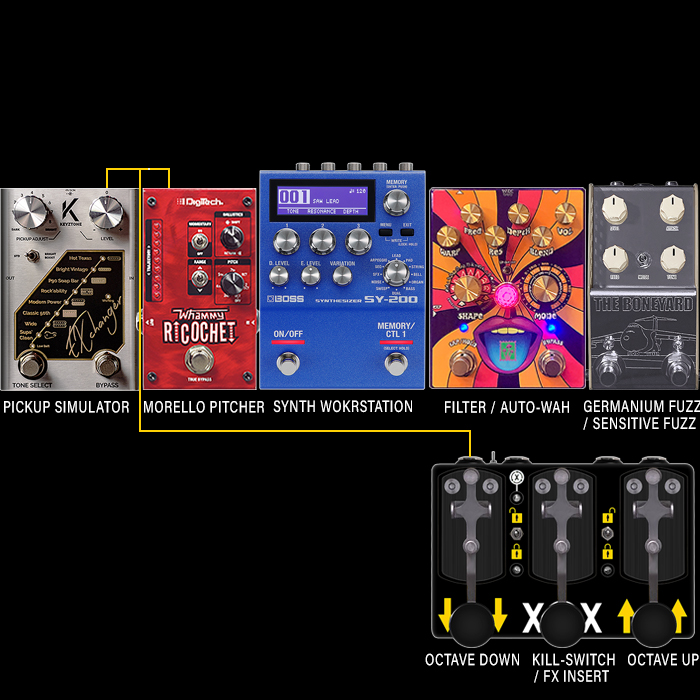
The first 5 slots of the chain are occupied by :
- Keyztone EXchanger Pickup Simulator - 8 Key Types
- Digitech Whammy Ricochet Tom Morello-style Pitch-Shifter
- Boss SY-200 Guitar Synthesizer Workstation
- All-Pedal Macrodose Multi-Filter and Auto-Wah
- Germanium and other Input-Sensitive Fuzzes
In fact the Coppersound Triplegraph on slot #14 is inserted between the EXchanger and Ricochet.
All six slots accommodate input-sensitive pedals which need the strongest guitar signal to operate optimally - for individual note-tracking and the like.
There's a fair amount of movement / rotation in the chain particularly on slots #2 and #5 here. #5 is mostly Germanium and Hybrid Fuzzes, while some Silicon Fuzzes too operate better here - this is typically the most rotated slot as pretty much half my 700 or so reference collection consists of Fuzzes!
Note that some prefer the Compressor right at the start of the chain - but for me it works better on its permanent slot #7.
The 3 Key Tone Enhancers / Sweeteners / Boosts
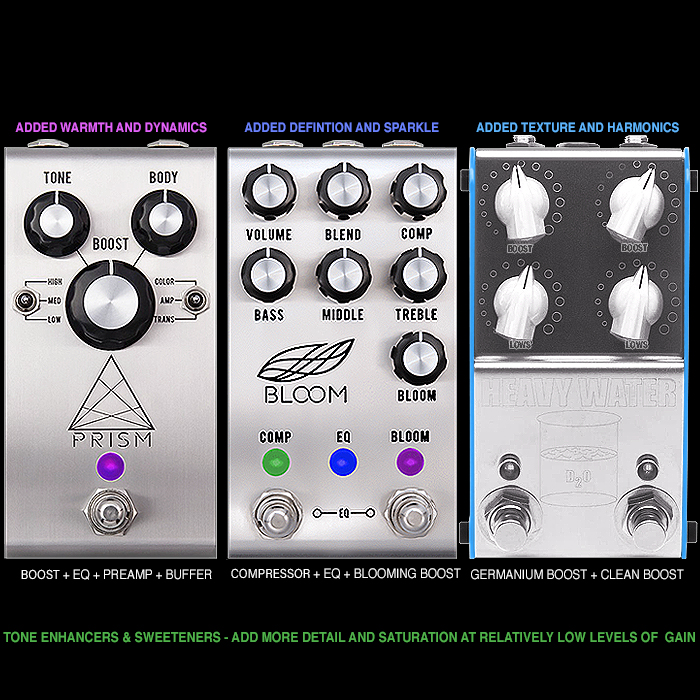
With a home-play pedal platform setup - operating at relatively low volumes - it can be tricky to get the right degree of definition, detail, texture and harmonics. The concept of Tone Enhancers is not new - in fact nowadays we're seeing very specific devices like 29 Pedals Euna and Oamp, and Source Audio's recent Zio.
Before all of those materialised I had already devised my own system for adding detail and saturation at relatively low levels of volume - and the trio deployed makes just the right beautifully textured sound. I've tried to switch out components but nothing sounds quite as good as these three in combination. Where each has a significant feature set on its own - while the combination of all three in tandem is pretty unparalleled! The Bloom and Heavy Water are particularly multi-functional - each essentially with 3 core modes of playback :
The 3 Initial and Key Boosts are :
- Jackson Audio Prism Boost + EQ + Preamp + Buffer
- Jackson Audio Bloom Compressor + EQ + Blooming Boost
- ThorpyFX Heavy Water Dual Boost - Texturising / Harmonic Generating Germanium Diodes Boost + Clean Boost
The Gain Section
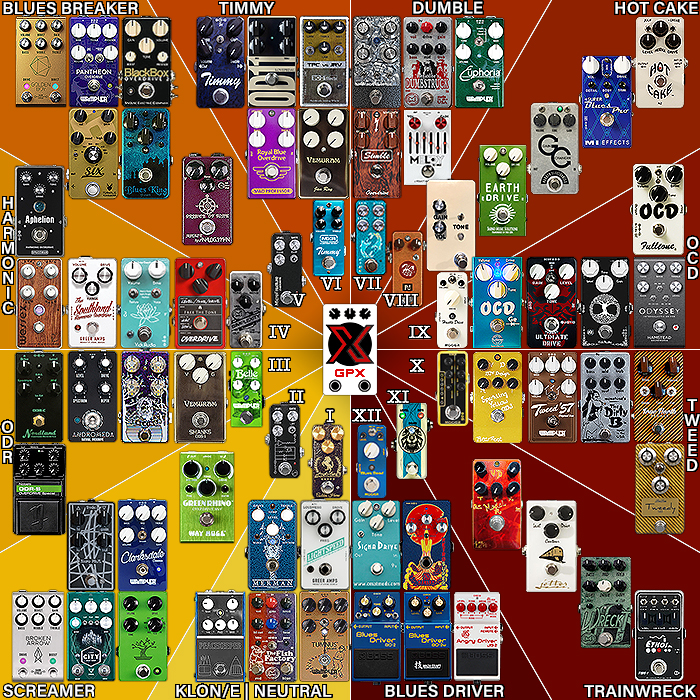
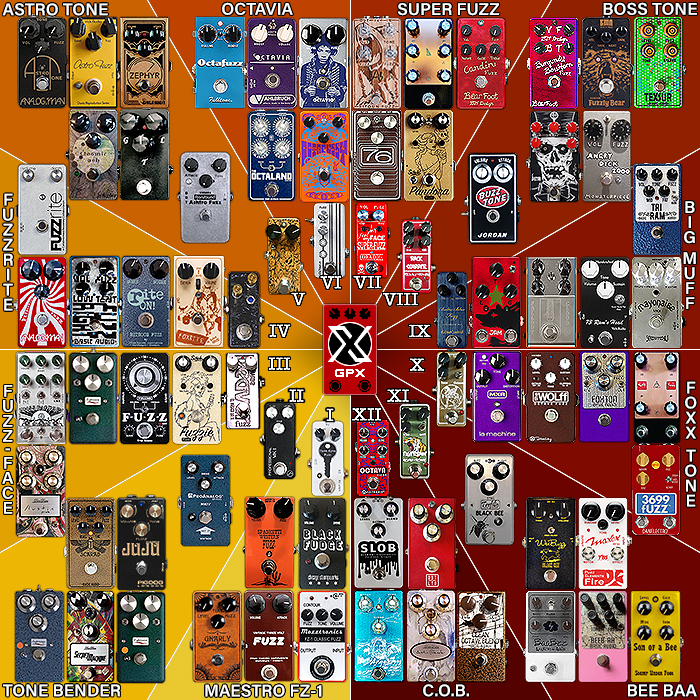
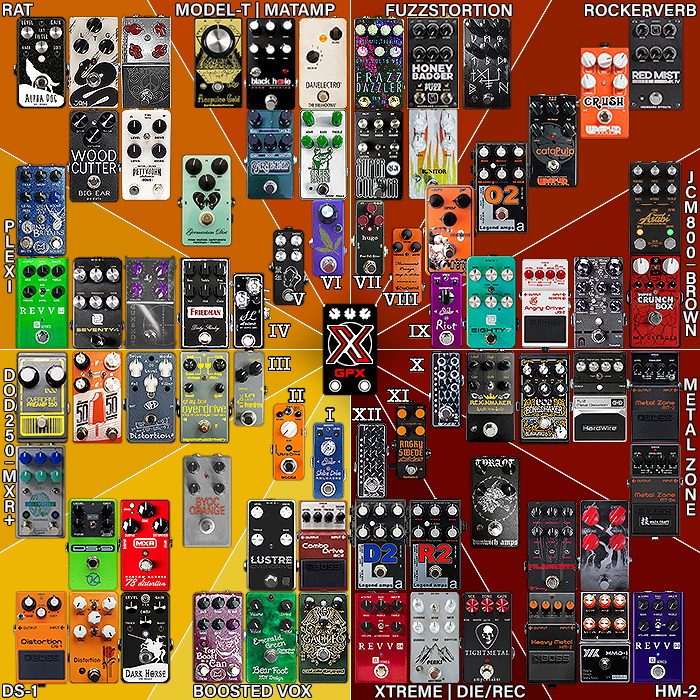
The Gain Section in fact starts before the 3 Tone Enhancer Boosts just covered - on slots #6 to #8. Actually the Germanium / Sensitive Fuzz slot #5 is officially the first in the Gain Section - and then goes all the way through to slot #27 - over half th e chain in fact and a total of 22 different devices. (Slot #14 is the TripleGraph Octaver).
as
I've obviously recently published my Favourite 25 Guitar Heroes - so there is a very broad range of tones to replicate there. I always have at least one or two or three Marshall-style boxes, including an EVH Brown Sound Type - also a Top Boosted Vox Brian May type thing - and everything from clean boost through transparent, bluesy and hard heavy distortion. A number of the slots are dedicated to fuzzes - where there are in fact 5 on duty per the top visual.
The idea is to give me the broadest tonal palette - with almost infinite textures and variances. I've often likened my pedal-chain to a Spice Rack or Painter's Palette even - where you have all the different colours of the 12 Degrees Spectrum at your fingertips. The rig is more of a comprehensive studio setup in that way versus any kind of practical touring setup.
There is dual purpose in this too - as there is in most of what I do - the nature and structure of that section allows for easy switching out of pedals - while minting the baseline of the signal tonality. I am so accustomed to how the core of the system sounds - that I can immediately determine the impact of a new pedal. So even with the amount of chopping and changing I do - which is around half a dozen to 10 per week and with as much as half of the pedal-chain changing each month. While it's vital for me to retain and maintain the baseline for accurate benchmarking and comparisons purposes.
Generally the chain roughly follows the 12 Degrees Spectrum - which a few incidentally quirks in-between.
A big part of the chain is also the numerous EQ and Boost pedals - so you can enhance and balance your tonality relatively easily - both upstream and downstream as such!
22 Gain Pedals to cover all bases! :
- ThorpyFX The Boneyard Germanium Multi-Bender Fuzz
- Jackson Audio Prism Boost + EQ + Preamp + Buffer
- Jackson Audio Bloom Compressor + EQ + Blooming Boost
- ThorpyFX Heavy Water Dual Boost - Texturising / Harmonic Generating Germanium Diodes Boost + Clean Boost
- Decibelics Golden Royale Dual Stackable Klon(e) with Bass Boost and Clipping Options
- Redbeard Angry Rhubarb Paradynamic Overdrive - really elegant and powerfully versatile Drive unit
- Keeley Modded Boss BD-2 Blues Drive with Phat and Freak Fuzz Mods
- Demon Pedals Kondo-Shifuku D-Style Drive
- Strymon Riverside Multistage Drive / Boost / Distortion - with 3-Band EQ
- Chase Bliss Audio Automatone Preamp MKII Multi-Drive + Fuzz Face Style Fuzz
- DSM and Humboldt Silver Linings Multi-Drive
- Pettyjohn Custom Chime II Vox style Drive / Distortion
- Pettyjohn Custom Gold II Marshall Plexi style Drive / Distortion
- Chase Bliss Audio Analog Gain Stage Dual Channel Boost / Overdrive / Fuzz - here deployed as Multi-Fuzz
- TX Pedals Animalizzer Multi-Muff / MufferFuzzer Fuzz / Boost / Overdrive / Distortion
- Dr Scientist Frazz Dazzler Versatile Heavy Fuzz - Straddles Big Muff and Rat Opamp tones
- Strymon Sunset Dual Overdrive - particularly for its Boosts
- Tsakalis Audioworks Room #40 MIAB Plexi + JCM800 with Variac - perfect for EVH Brown Sound
- Sinvertek N5+ 3D Gold Special Edition All-Round Killer Distortion
- Drunk Beaver Heavy Bat Multi-Rat with 4 different Opamps, Multiple Clipping Options, 3 Channels and 3-Band EQ
- Frost Giant Electronics Architect of Reality Dual Channel Hot-Rodded JCM800 style Distortion
- REVV G4 Fat High Gain Distortion
The Purpose of the Multiple EQs and Boosts Peppered throughout the chain!

You will note from the diagram that we have a number of instances of useful Boosts and EQ's peppered throughout the chain. And where said pedal can deliver a clean boost - then you can wholly deploy some shaping of the EQ too.
Obviously I have 3 Boosts right at the start of the chain, and then the ones I mostly use regularly are the two Strymons - Riverside and Sunset - while it's handy to have boosts both up and down-stream which can delivery ether textured or entirely clean boosting. A number of vintage-inspired / authentic circuits have relatively low volume output - which usually call for me to deploy the Treble Booster on the Sunset - the handy thing is you can control how full-frequency that is - so you can definitely add volume and enhance as is required.
For pre-boost I rely mostly on the facility of the JA Bloom - where I can easily switch that in and out, while the Riverside also gets used quite a lot - to add further warmth or just a hair of gain!
So there are in fact 9 slots which get applied fairly regularly as boost - #6, #7, #8, #13, #16, #19, #20, #22, #29
There are two main EQ's in the chain - the JA Prism at #6 which kind of sets the core tonality, and then the Boss EQ-200 on slot #29 which I deploy as a Balancing / Levelling EQ right after the heavy section and noise gate - to return some of the highs lost along the cabling and in the noise gate.
After those I mostly deploy the 3-Band EQ on the JA Bloom - in particular to cut low end and prevent flubb. Overall there are 8 slots where you can deploy the EQ to augment or enhance the signal - or else compensate for signal or frequency loss in certain areas. The slots involved are - #6, #7, #13, #15, #16, #20, #22, #29.
This is all about dynamics and flexibility really - I essentially call these elements 'Tone Components' - which I can quickly deploy to fix any issues I may be experiencing. It's like a mechanic knowing a particular engine - and knowing exactly what to adjust to ensure optimal and smooth running!
The Utility Pedals
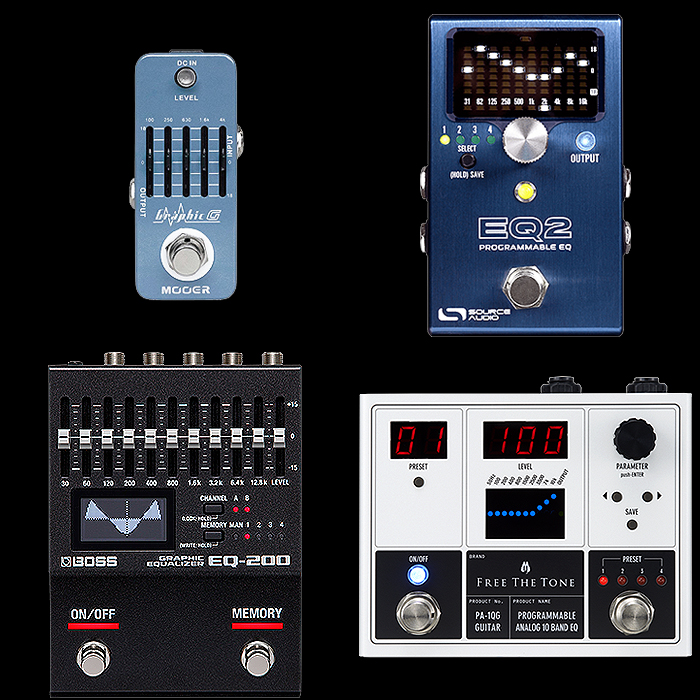
Here we're really just referring to slots 28 and 29 - namely the Noise Gate and 10-Band EQ.
I've tried a number of Noise Gates throughout these years - and ended up with both a stock Boss NS-2 as well as an infinitely preferable Alchemy Modded NS-2 variant which has been my mainstay for years - it just works brilliantly for me - and I have no complaints. I've often considered whether I should be trying out the TC Electronic Sentry or the newer REVV G8 and KMA Machine Pylon in particular. But the Modded NS-2 has always been perfect for me and has never let me down - so it will probably stay for a few years more - even though I am tempted by the Pylon in particular - but don't really need that extra balancing boost - as that's what the Boss EQ-200 is used for - the very next pedal.
For a longe time I had deployed an Alchemy Modded Boss GE-7 - while the EQ-200 is a cut above that - and really is my perfect EQ. I like proper analog slider EQ's with immediate tactile tweakabilty - versus the digital variants. The EQ-200 then allows you to save several different presets - so you can deploy the EQ as a Boost and Tone-Shaper as well as for 'Balancing' duties - which is what I currently mostly use it for - to restore Highs that may have been lost along the cabling or else inadvertently rolled of slightly by the Noise Gate.
I've considered several different options in this area - but this really does seem to be the perfect pairing for me.
The Modulation Section
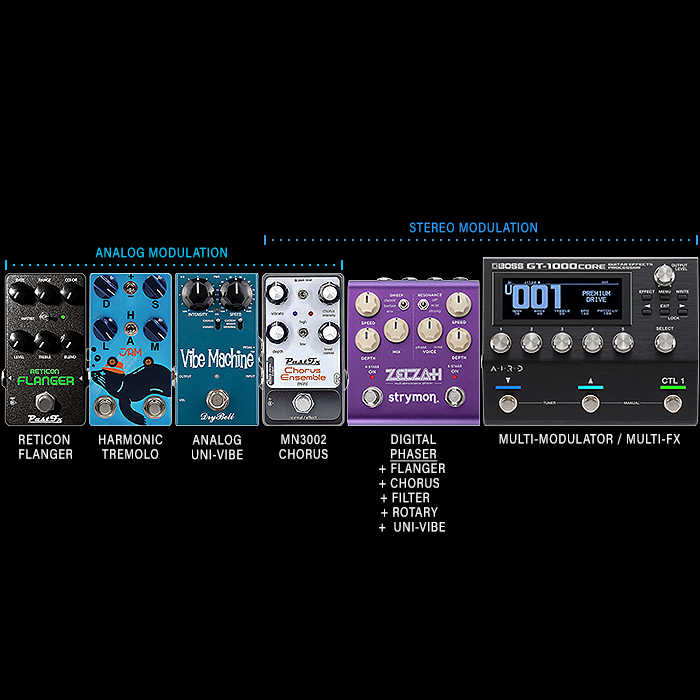
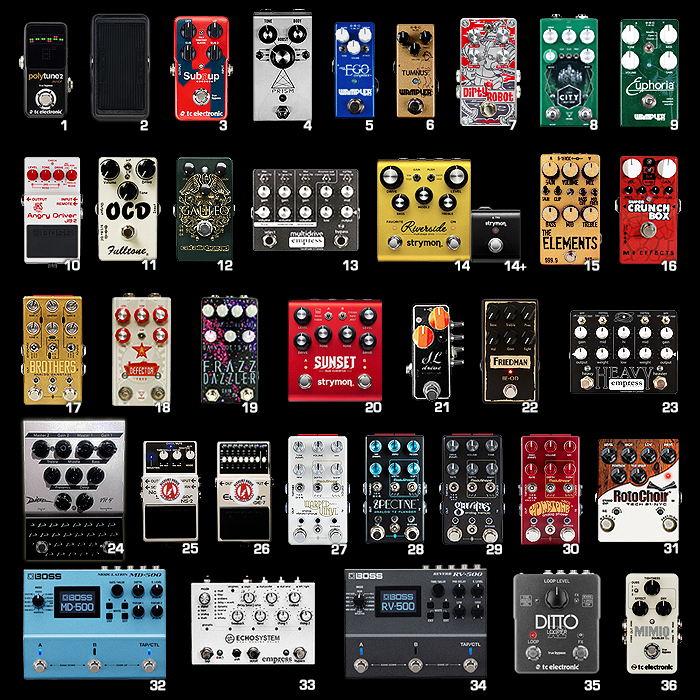
Spice Rack Edition of Pedal Chain - December 2017
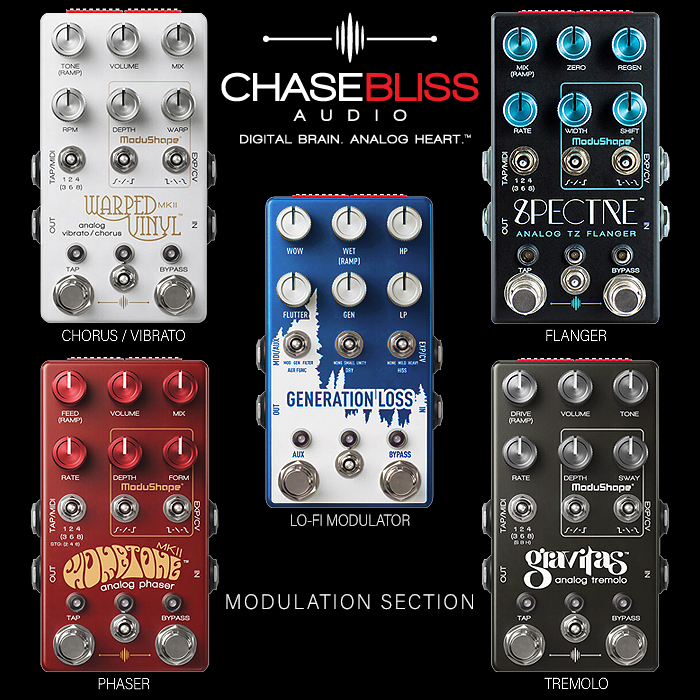
In my first 'Pedal Chain Delight' arrangement I was purely using the Strymon Mobius for quite a while - before I became enamoured with Chase Bliss Audio - starting with the Gravitas and then evolving until I had all 4 CBA Modulations in the chain.
The Modulation Section historically always used to be Analog entirely - with very few exceptions, while it has evolved more recently to accommodate both Analog and Digital Effects - while I typically favour the Analog varieties.
In the current arrangement we start of with 4 Analog Modulations, the Strymon Zelzah then starts off the digital part, which is bookended by the Boss GT-1000 CORE. Again traditionally I've always had a digital multi-modulator too - which started with the Strymon Mobius, then Boss MD-500, then Empress Zoia, GFI Synesthesia - and GT-1000 Core. The last 3 pedals are importantly output in Stereo too - which makes a huge difference for modulations and spatial effects!
This section changes a lot and gets reorganised fairly significantly all the time as stereo pedals need to go towards the end - so it has totally shifted the previous customary placements of those pedals - where traditionally the chorus always used to come first. I also drop the occasional modulation further up-stream - mostly say the MXR Phase 95 Mini - while there is a lot of ongoing flexibility which often has 5 analog effects, sometimes 4 analog plus the Cooper FX Arcades - nothing is holy here really apart from Stereo output - the pedals will be reorganised as necessary to be accommodated to the maximum impact and effect.
This is the current Modulation arrangement - while I have several other favourites including the ThorpyFX Camoflange and Pulse Doppler in particular, also the Sitek Phasia - while my 5th modulation historically used to be Rotary (mostly the Tech 21 NYC RotoChoir), while I mostly used the Josh Smith settings on the Eventide H9 for that these days - or the one from the GT-1000 CORE.
The Synesthesia would be my ultimate Multi-Modulator if only it had Stereo inputs too. Back in the day I used almost entirely mono Analog modulations - while recently I've been using more Stereo varieties - which makes the Synesthesia somewhat unusable in that context. I'm hoping either GFI sort that out with a TRS update, or else Source Audio finally deliver its much awaited Multi-Modulator in the same format as the Ventris (Dual Channel!).
The Modulation section aways consists of slots #30 - #35 - while there is a lot of rotation and slot-hopping too as needs must. Pictured selection is :
- PastFx Reticon RD5106 BBD Analog Flanger
- JAM Pedals Harmonious Monk Harmonic and Amplitude / Bias Tremolo
- DryBell Vibe Machine V3 Analog Photocell (bulb) Uni-Vibe
- PastFX MN3002 BBD Chorus Ensemble Mini Analog Chorus / Vibrato with Stereo Output
- Strymon Zelzah Multidimensional Stereo Phaser / Flanger / Chorus
- Boss GT-1000 CORE Stereo Guitar Effects Processor / Multi-Modulator / Multi-FX
The Stereo Time-Based Effects
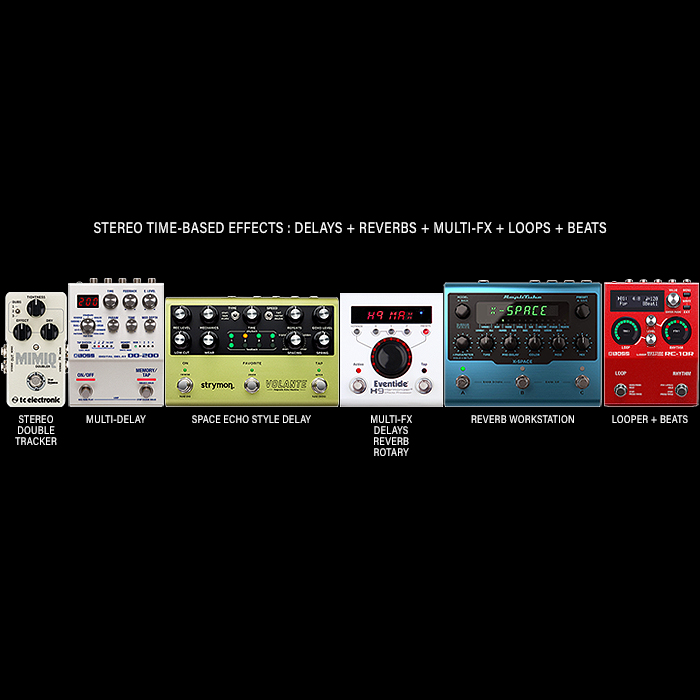
This has evolved over the years - where you can see from the original 'Pedal Chain Delight' arrangement of 25 - that back then I only had the one Delay Workstation, one Reverb Workstation, and the TC Electronic Mimiq Double Tracker Fairy Dust Sprinkler!
It has evolved to essentially 3 Delays, 2 Reverbs (I originally acquired the H9 Max principally to use as a Reverb unit), and then the Looper at the end with Beat Machine onboard.
My favourite all-time delay is actually the Empress EchoSystem, while my favourite style of Delay is Vintage Tape Style - in particular Boss / Roland's Echo Space and versions thereof. So over time my main Delay unit became specifically a Tape Style one - and I had to then supplement that with a more all-rounder Multi-Delay. I would have liked to have accommodated the EchoSystem ideally - while in the end the Boss DD-200 is a better fit - I do though rotate the EchoSystem back in again fairly regularly - in place of the main Tape Delay unit.
I have always had a Reverb Workstation - first the Strymon BigSky, then the Boss RV-500, then Source Audio Ventris, EHX Oceans 12, Strymon NightsSky, Neunaber Illumine and current favourite the Ampltube X-Space. I of course retain all my pedals and rotate them on each pertinent slot relatively regularly - while some inevitably get a little neglected - but not intentionally!
In any case I always liked the algorithms on the Eventide Space unit - but it was always a little hefty for me - so I leapt at the chance of acquiring those Reverbs in particular via the H9 Max - which mostly supplements the main Reverb Workstation unit - but also contributes other key effects - like the Josh Smith preset for Rotary Speaker!
The Looper at the end of the chain got added about half way through the evolution - where it was the TC Electronic Ditto X2 for the longest time - before Boss's killer RC-10R emerged. The RC-10R is so close to being my perfect looper / beat-box - but the stereo output volume for drums / beats just isn't quite loud enough to be 100% useful. I'm still waiting on an update to resolve that!
Generally though there is about as much Delay and Reverb here that you could ever need - with the H9 supplementing those other units.
Power and Cable
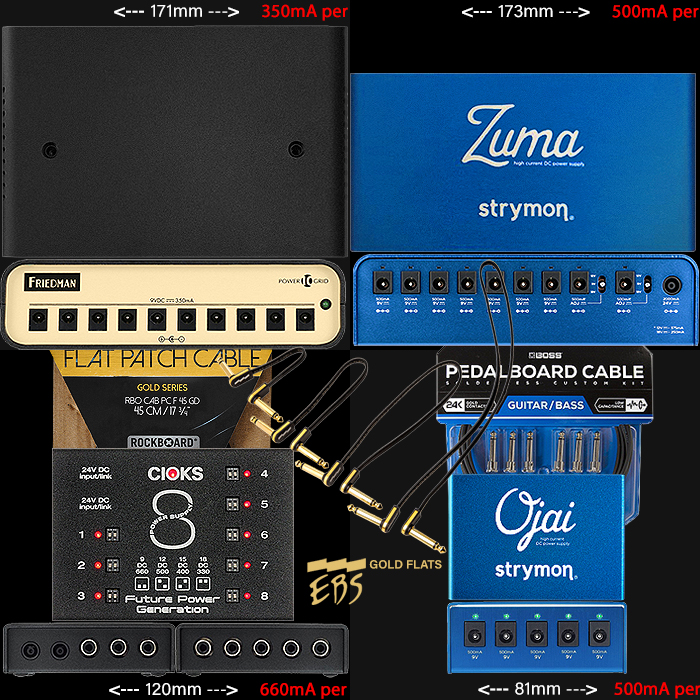
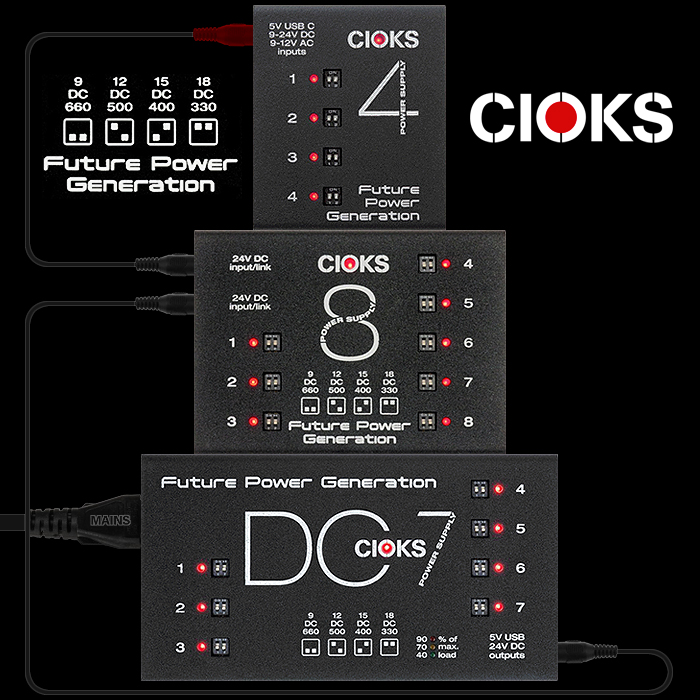
The whole power-supply area is another Tetris-like exercise in figuring out how you are going to power all your pedals - or 41 in my case. I've tired a number of supplies over the years before I've settled on the 3 brands I use. I believe those are the best of everything out there for my particularly needs - with Cioks just a step above everyone else - with your being able to select 9 /12 / 15 / 18V outputs on every outlet.
The Friedman is there for the numbers - at 10 slots per unit x 2, the Zuma has 9, the Cioks 8, and the Ojai 5 - for a total of 42 Isolated Outlets as follows:
- 2 x Friedman Power Grid : 2 x 10 Isolated Outlets @ 350ma each
- 1 x Strymon Zuma : 9 Isolated Outlets, 7 @ 9V / 500ma, and 2 Selectable at 9V / 500ma | 12V / 375ma | 18V / 250ma
- 1 x Cioks 8 : 8 Isolated Outlets, all 9V / 660mA | 12V / 500ma | 15V / 400ma | 18V / 330ma
- 1 x Strymon Ojai : 5 Isolated Outlets all @ 9V / 500ma
Both Cioks and Strymon are modular - where you can chain several units together, in fact I power the Cioks 8 off the Zuma. Cioks is by far and away the smartest operator here - with for sure the most compact, powerful and versatile units! I'm delighted with the combined output of my quintet here which is absolutely perfect for my needs!
NOTE that Cioks have their own kind of power leads - utilising more robust audio / phono style plugs at the power-brick end! So you need to buy a whole assortment of those - and where the longer lengths aren't always that readily available - I had to buy most of mine in from Thomann as far as I recall!
I've said many times before that EBS Gold Flats are my absolute favourite pedal patch cables and I've had those in place right from when they first materialised - and they connect up 99% of my pedals near enough. They don't do particularly long lengths so I deploy a few Rocboard Gold Flats too, and the occasion Boss Custom Patch Cable for more specialist / longer applications. EBS has an even more compact High Perfomance Flat series out - which I would buy into if I were new to all of this. As things stand though the combination of these power supplies and those gold flat cables has resulted in near flawless and noiseless running for several years now! Everything pretty much works perfectly - so there is no incentive to keep trying to change things up. At some stage I may start to swap in some EBS High Performance cables - but that's somewhat off now!
Instrument Cable & Wireless
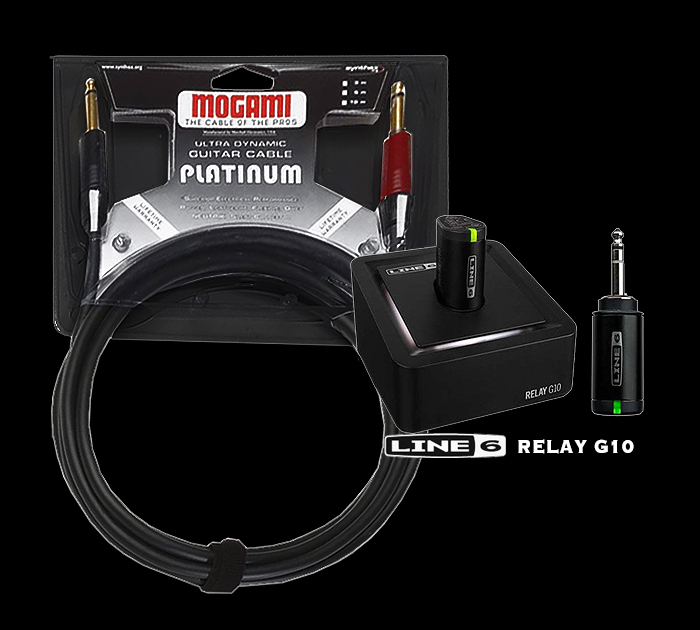
Like everyone, I started on wired instrument cables - initially various Planet Waves one - Classic, Custom and American Stage, and then like many I graduated to Mogami Platinum - where I stayed.
Mind you I did not stay for too long as I was getting fed up being entangled and encumbered by cable - so I swiftly switched to a wireless solution. Back then the Line 6 Relay G10 was about the only one generally doing the rounds - where today you actually have numerous options - including some great devices from Boss and Korg in particular.
And even though there was some kind of recall on G10 devices - where they had a tendency to overheat and explode - Mine has been all smooth running from the very start. It just works seamlessly and brilliantly - delivers great tones, and there is no noticeable lag - not even under the fingers.
I would generally encourage everyone to go wireless as it just makes everything much much easier. And the Line 6 Relay G10 has proven to be quite superb for me all these years!
Amps and #1 Guitar
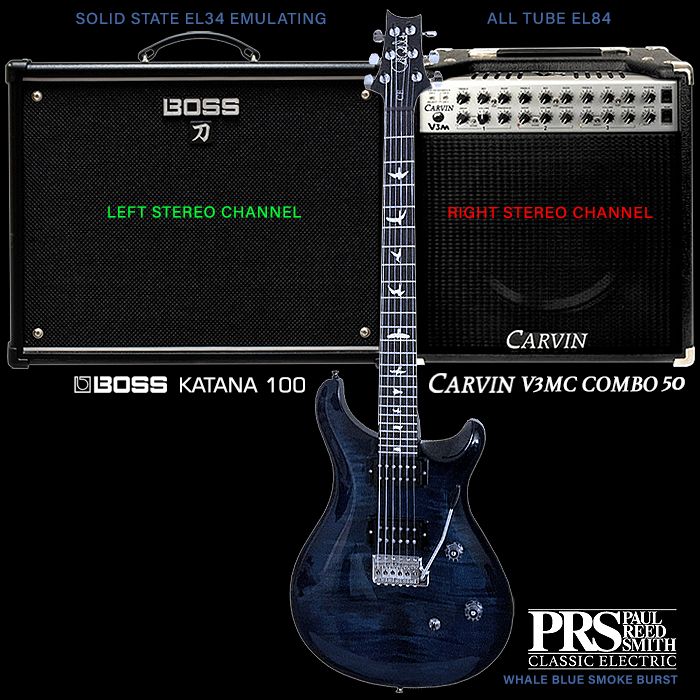
So the very first thing I bought for my guitar renaissance was the pictured Whale Blue Smoke Burst PRS CE (Classic Electric) of that first batch of the revived PRS bolt-on guitars. It's of course mostly made in Maryland like the Core PRSs while the bridge and some of the electronic parts are import parts - whatever that means.
The first thing I did was to attach Schaller straplocks and one of those supremely comfortable Signature Padded Leather PRS Straps - which are weirdly not made any more. I then switched out the pickup rings from white to black - and the switch tip, and a little later swapped the import bridge for a Core USA one. And that's how it's remained ever since. The 8515 pickups are perfect for a pedal platform rig - as they are relatively neutral - while being full frequency range too. And your output signal is only ever going to be as good as what you put into it!.
While I have other guitars - the Blue CE (named Calliope 'the beautiful-voiced' after the Greek Muse) is by far and away my main one - and it's a wholly natural extension to my hands - everything just feels right. Also at the time it was the only PRS CE with dark headstock and neck - which I rather like. The Bolt-on neck gives it some snap and sparkle, and there is plenty of low end available too - just a beautifully balanced instrument all round.
I went through a couple fo weird amps before the Fender Mustang III. And acquired a Hughes & Kettner Tubemeister 18 at around about the same time as my Boss Katana 100.
Not long after that I came across the Carvin V3MC which really was exactly what I was looking for in a Tube Amp - I had to import that in from Germany - as I believe there were no longer any Carvin stockists left in the UK.
The Boss Katana 100 which is sort of EL34 emulating is the perfect complementary amp to the EL84 tubes of the Carvin V3MC. For me that was an early part of the science - much like combining Tube Screamers with Blues Breakers or Mid-humped pedals with slightly scooped ones. The Katana and V3MC really fill out each other's frequency profiles - and the EL84's brightness and sparkle is superb agains the slightly darker, denser and bassier Katana profile. Each of those Amps took a very long time to tune in and balance just right!
I've been meaning to get a Boss Katana Artist II for the longest time now (to replace the Katana 100) - but my rig sounds so good these days - and I really don't want to spend another couple of days recalibrating and balancing the rig all over again.
Generally though the formula here is full frequency range with the deeper one amp combining with a more sparkly second amp for extraordinarily detailed and complex output texture and harmonics!
The Pick of Destiny!
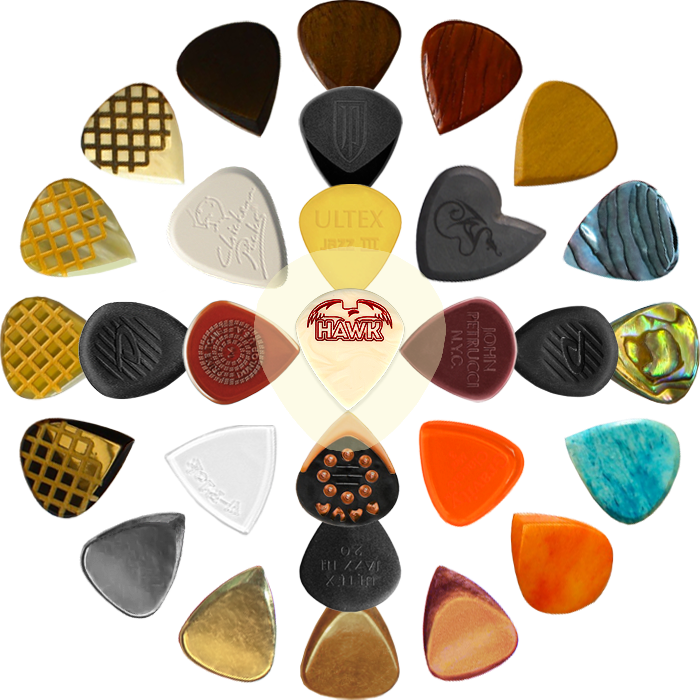
I spent the best part of nearly a year to find the perfect pick for me and must have auditioned a few hundred along the way - including every conceivable Dunlop variety.
I very early on discovered that it was all about the smaller Jazz III picks for me - those were the ones that felt the best for me and were the most effortless to use. In fact a sign of a good pick is that you're not really aware of it - it just seems like a very natural extension of your fingers - and you don't really need to think at all about how you grip or operate it.
So I tried various brands - different plastics, resins, shell, wood, metals, stone and bone until I ended up with the Hawk ToneBird 7 picks - which pipped my previous favourite Dunlop Ultex types.
Every single one of the elements in my chain has been an essential discovery for me, and I feel very privileged to have found so many favourites along the way.
That doesn't mean things cannot be improved - but we're talking very tiny margins nowadays - in any case the ToneQuest carries on restlessly and ad infinitum. The task as always to seek out the best and most innovative solutions...
Final Thoughts

So I hope you have enjoyed the journey so far! But like I just said above - the journey is far from over. There are still quite a few varieties that I have yet to sample, and I'm not 100% satisfied with every single slot in the chain - while it's getting incredibly close now.
Also you need to take all the ongoing rotations with a pinch of salt. It's a major encumbrance to keep rotating quite so many pedals and chopping and changing all along the way - so that when I get something that really works I'm quite happy to have it sit on a slot until some a new challenger comes around - or I want to try new things.
The above arrangement features just one of many possible perfect implementations, and I've not done the maths for a while on exactly every pedal of mine which is the favourite for its slot. Some are more present and perennial than others - but there could be all manner of reasons for that, and some fantastic pedals get bumped off prematurely just because I have such an influx of new ones - so not every pedal here necessarily gets a fair innings. But since I retain each and every one - the worthiest for sure get multiple opportunity to get back into the chain.
I've really tried to include all the pertinent facts here - and hopefully this provides answers for all the questions you have raised in my direction as regards my pedal-chain.
And on with the Quest!

